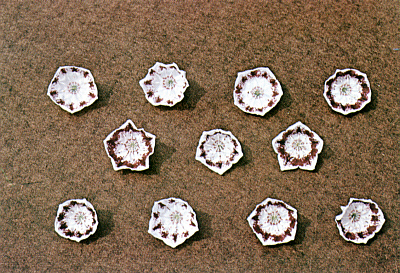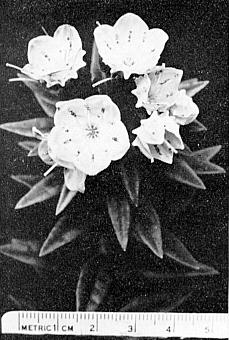The Kalmias and Their Hybrids
Richard A. Jaynes, Associate Geneticist
The Connecticut Agricultural Experiment Station
New Haven, Connecticut.
Mountain laurel,
Kalmia latifolia
, has long been considered a companion plant for
Rhododendrons
, but how many gardeners have seriously considered the other species of laurel or even sought out different types of mountain laurel? When I started to work with the laurels ten years ago I found, much to my surprise, that no genetic or breeding work had been done with them. A delightful opportunity for a recent graduate employed in a genetics department of a state experiment station; whose state flower, incidentally, just happened to be mountain laurel.
I would like to acquaint you with the species in the genus and tell you of some of our research with the natural variants that have been selected in the wild and in nurseries. The taxonomists are yet to be heard from on the exact number of
Kalmia
species. I shall say seven and discuss the six that are native to continental United States. The seventh species,
K. ericoides
, is native to Cuba.
Sandhill Laurel,
K. hirsuta
The sandhill laurel is native to the coastal plain of South Carolina, Georgia, northern Florida, and Alabama. The flowers are small replicas of mountain laurel, except that the inner pigmented ring at the base of the corolla is often missing. They are borne singly in the axils of the leaves (Fig 51). The leaves, which only measure 1/2 inch in length, are very hairy, hence the Latin name
hirsuta
. Mature plants are usually less than 18 inches tall, but may be straggly. Compact, multi-branched clones need to be selected for garden use. Flower size varies as does the lobing on the corolla, and the color may be anything from near white to deep pink. The plants are not winter hardy in Connecticut, probably USDA Zone 7 (e.g. Washington D.C.). The seeds are difficult to germinate but greenwood cuttings will root.
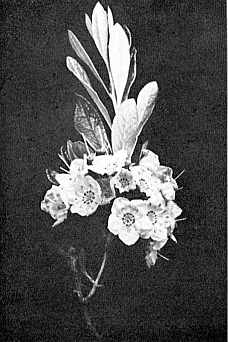
|
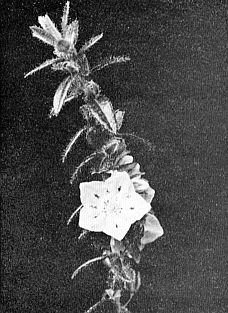
|
|
FIG.50. White wicky (
K. cuneata
).
The cream colored flowers open 2 to 3 weeks after mountain laurel. |
FIG. 51. Sandhill laurel (
K. hirsuta
).
Actual length of leaves about ½ inch. |
White Wicky,
K. cuneata
White wicky is the only deciduous laurel. It is native to a small area of the Piedmont and Coastal Plain of North and South Carolina. The flower is cream colored but may be accented with a bright red ring of pigment at the inside base of the corolla (Fig. 50). Plant height is usually less than 2 feet. Leaf shape and plant habit most closely resembles that of sheep laurel. Plants are winter hardy in Connecticut (Zone 6), if some dieback of branch tips is overlooked. Cuttings are difficult to root and the seed requires moist-chilling to germinate. It is definitely worth having in the garden.
The bog laurels: eastern and western alpine,
K. polifolia
and
K. microphylla
(also known as
K. p.
var.
rosmarinifolia
and
K. p. microphylla
, respectively).
The eastern bog laurel grows in the northeastern United States and eastern Canada and as far west as Saskatchewan. High altitude or northern collections remain compact and 6 to 10 inches high, whereas other sources of the species are taller and leggy.
The closely related western alpine laurel may be nearly prostrate (Fig. 53) with the taller sources of the species not growing over 9 in. tall. Unfortunately for the rock gardeners in the eastern United States it dislikes our long summers and open winters. Flower color of both species ranges from a light mauve pink to a deep magenta. White forms have been reported. The two species can be readily crossed and the hybrids (triploids), which produce no seed, show promise as rock garden plants.
(K. microphylla
, 2n=24, x
K. polifolia
, 2n=48 hybrid, 3n=36). They are hardy, compact and cuttings root readily.
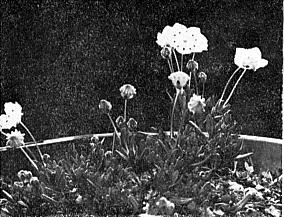
|
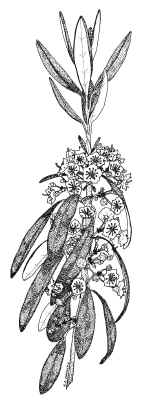
|
|
FIG. 53. (left) Alpine bog laurel (
K
.
michro-
phylla) from the Cascade mountains of Oregon. Total height of plant including flower about 2 inches. FIG. 54. (right) Sheep laurel ( K. angustifolia ). |
Sheep Laurel,
K. angustifolia
Sheep laurel is native from the Carolinas, north into Canada and westward to Minnesota. Plant habit and flower color is variable. Mature plants may be 10 to 36 inches high, and, as with bog laurel, the more compact growing plants are found in the northern part of the range or at high elevations. Flower color normally varies from light lavender-pink to a deep wine-red, but forms with pure white flowers are known. The presence of pigment is due to a single dominant gene. If two white flowering clones are crossed all the seedlings will also be white flowering. Sheep laurel is strongly stoloniferous, a valuable characteristic where they are to be used as a ground cover. but a disadvantage for specimens that are required to stay in bounds. The flowers are borne in small clusters encircling the stem, giving a cone-like appearance to a flowering branch (Fig. 54). Several forms and varieties have been named such as:
rubra
, for the deeply pigmented flowers;
pumila
, for the small habit;
ovata
, for the oval leaf shape; and
candida
, for the white flowers. Greenwood cuttings root readily. Selections of sheep laurel should become available as soon as nurserymen growing container stock become familiar with handling them.
Mountain Laurel,
K. latifolia
Little has to be said of the attributes of the common mountain laurel which is native from Alabama to Maine and has been picked as the state flower of Pennsylvania as well as Connecticut. In fact some writers have thought it to be the most beautiful shrub in the United States, surely a point to be contested by rhododendron enthusiasts, but indicative of the beauty of this lovely flowering broad-leaf evergreen. Cultivars of mountain laurel were named as early as 1840 and at least 90 names have been applied to different forms of the species. Isn't it surprising then that there is no large scale nursery production of any named kinds! The reason, of course, is that they are difficult to root, costly to graft, and untrue from seed. However, this is changing. Rooting will become practical as newer methods are used and the techniques refined. In addition there will be selection among the best clones for those that will root most readily. Genetic studies are showing the way to obtain selected types true from seed.
Let's look at some of the mountain laurel selections:
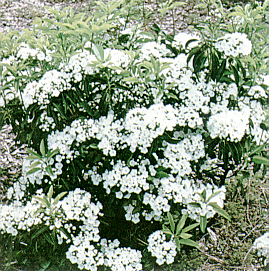
|
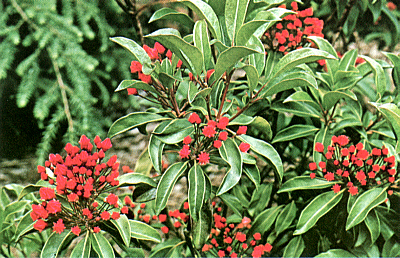
|
|
| White flowered mountain laurel. | Red-budded mountain laurel. |
Whites - These are white in bud and flower when grown in shade or full sun, except for a faintly colored ring on the inside base of the corolla or occasional spots where the anthers are held. White appears to be dominant in crosses with deeply pigmented plants. True breeding lines should be readily developed.
Deep Pinks - These forms have a rich color in bud as well as in open flower. Control seems to be by several genes and so the trait may be difficult to fix in a true breeding line.
Red-buds - Clones such as 'Ostbo Red' have intense pigmentation in the bud and yet open to a near white or pink on the inside of the corolla. Recessive genes control this redbud trait. Seedlings from crosses among red-bud forms are thus all true to type.
Feather petal, f. polypetala - In this variant the corolla is split into five strap-shaped petals. A garden oddity, but of limited merit unless forms are found where the petals are broader and have more body. Our crosses indicate that expression of this trait is controlled by a single recessive gene.
|
|
Many other selections for foliage, compact habit, large flowers, etc. have been named over the years, but perhaps enough have been noted to suggest that there are mountain laurels other than just "the common mountain laurel".
Before leaving this species, though, something must be said about the geographic variation of hardiness in this as well as other species which have a deep north-south range. Some of the northern sources of mountain laurel are hardy in Zone 4, yet there are southern sources that will not survive in Zone 6. We are aware of this kind of variation in rhododendron species too, but it is all too often forgotten or neglected. Yet, it can literally he a matter of plant survival.
Propagation. You can't talk about mountain laurel for very long without being asked about its propagation so 1 will summarize some of my thoughts on the subject. In general, techniques used for starting rhododendron seeds are also satisfactory for laurel seed. For rapid seedling growth the medium should be maintained at 70 to 75° F.
Grafting of mountain laurel is not difficult. I have had good success grafting in mid-June when the laurel is in bloom. Young plants are potted and cleft grafts made on one or more branches. The scions are of the current year's growth and they are grafted onto last year's growth of the stock. Grafts are kept in a plastic tent for 6 weeks, gradually hardened for 2 more weeks, then placed in a lath house where they over winter.
Greenwood cuttings of sheep, bog, and sandhill laurel will root under mist or in a plastic tent. The results with mountain laurel are something else! The rooting results with a pink selection are typical: In 1969, 11 cuttings were taken in the fall and all rooted by February; whereas the following year (1970), of 18 cuttings taken at the same time in the fall, only 2 rooted. However, in 1970, 8 cuttings were also taken from the small plants that had resulted from the previous years cuttings; all 8 of these rooted. One of the major contributing factors to the sudden loss of rooting ability is ageing of the stock plant. This fact was substantiated by our rooting results last fall with 1600 cuttings from different selections and stocks of varying age:
- Stock plants, 4 or more years old - 21% of the cuttings rooted.
- Stock plants, 1 to 3 year old grafts or cuttings - 60% of the cuttings rooted.
- Stock plants, 1 year old - 89% of the cuttings rooted.
A plant tends not to "age" if kept vegetative by grafting, cutting or pruning. The rooting results were recorded in February after 19 weeks under mist or in plastic tents. The cuttings were given no auxin or fungicide treatment. Improvement of rooting could be expected with the proper use of such adjuncts.
Species Hybrids
Laurel species hybridize with each other only with difficulty, except for the cross of
K. polifolia
and
K. microphylla
already discussed. There are two other combinations which show promise.
One is the cross of sheep laurel and mountain laurel (
K. angustifolia
x
K. latifolia
) which has intermediate sized leaves and a dense, bushy growth habit. Cuttings root readily, but the hybrid is slow to come into flower. Plants are borderline hardy in Connecticut.
The other hybrid is a cross of mountain laurel with the sandhill laurel (
K. latifolia
x
K. hirsuta
). Some of these plants have foliage and habit similar to the evergreen azaleas but pruning may be needed to prevent legginess. Flowers are attractive, borne in small clusters, and appear much like those of mountain laurel (Fig. 52). Plants propagate readily from cuttings. They are not hardy in Connecticut, but probably are fine in Zone 7 and southeastern United States.
The laurel selections and hybrids mentioned here are a sampling of the wonderful variation available in this neglected group of natives. Except for mountain laurel and white wicky all can be propagated readily from cuttings, and some of the selected forms of mountain laurel can now be propagated true to type from seed. Although not described here, a means to mass produce of seed of mountain laurel and sheep laurel has been reported wherein selected pairs of plants are caged and bees introduced to do the hybridizing. If, after you leave these meetings, your thoughts should stray to the laurels as you are planning and working in and around your garden, and you discover more in this game than before, then I will consider my presentation a success. The laurels have been in the background of our gardens long enough.
